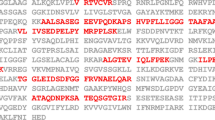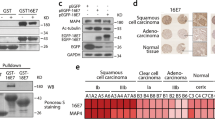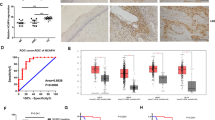Abstract
Histone deacetylase (HDAC) inhibitors induce an intrinsic type of apoptosis in human papillomavirus (HPV)-positive cells by disrupting the mitochondrial transmembrane potential (ΔΨm). Loss of ΔΨm was only detected in E7, but not in E6 oncogene-expressing cells. HDAC inhibition led to a time-dependent degradation of the pocket proteins pRb, p107 and p130, releasing ‘free’ E2F-1 following initial G1 arrest. Inhibition of proteasomal proteolysis, but not of caspase activity rescued pRb from degradation and functionally restored its inhibitory effect on the cyclin E gene, known to be suppressed by pRb-E2F-1 in conjunction with HDAC1. Using siRNA targeted against p53, E2F-1 still triggered apoptosis by inducing the E2F-responsive proapoptotic α- and β-isoforms of p73. These data may determine future therapeutic strategies in which HDAC inhibitors can effectively eliminate HPV-positive cells by an apoptotic route that does not rely on the reactivation of the ‘classical’ p53 pathway through a preceding shut-off of viral gene expression.
This is a preview of subscription content, access via your institution
Access options
Subscribe to this journal
Receive 50 print issues and online access
$259.00 per year
only $5.18 per issue
Buy this article
- Purchase on Springer Link
- Instant access to full article PDF
Prices may be subject to local taxes which are calculated during checkout







Similar content being viewed by others
References
Aguilar-Lemarroy A, Kirchhoff S, Whitaker N, Gariglio P, zur Hausen H, Krammer PH and Rösl F . (2001). Int. J. Cancer, 93, 823–831.
Almasan A, Yin Y, Kelly RE, Lee EY, Bradley A, Li W, Bertino JR and Wahl GM . (1995). Proc. Natl. Acad. Sci. USA, 92, 5436–5440.
Bates S, Phillips AC, Clark PA, Stott F, Peters G, Ludwig RL and Vousden KH . (1998). Nature, 395, 124–125.
Bernard HU . (2002). Antivirus Ther., 7, 219–237.
Boutillier AL, Trinh E and Loeffler JP . (2000). Oncogene, 19, 2171–2178.
Boyer SN, Wazer DE and Band V . (1996). Cancer Res., 56, 4620–4624.
Brehm A, Miska EA, McCance DJ, Reid JL, Bannister AJ and Kouzarides T . (1998). Nature, 391, 597–601.
Brooks CL and Gu W . (2003). Curr. Opin. Cell Biol., 15, 164–171.
Brummelkamp TR, Bernards R and Agami R. . (2002). Science, 296, 550–553.
Chan HM, Krstic-Demonacos M, Smith L, Demonacos C and La Thangue NB . (2001). Nat. Cell Biol., 3, 667–674.
Chen C and Okayama H . (1987). Mol. Cell. Biol., 7, 2745–2752.
Chomczynski P and Sacchi N . (1987). Anal. Biochem., 162, 156–159.
Classon M and Dyson N . (2001). Exp. Cell Res., 264, 135–147.
Cory S and Adams JM . (2002). Nat. Rev. Cancer, 2, 647–656.
Dean PN and Jett JH . (1974). J. Cell. Biol., 60, 523.
Dhein J, Walczak H, Baumler C, Debatin KM and Krammer PH . (1995). Nature, 373, 438–441.
Dyson N, Howley PM, Münger K and Harlow E . (1989). Science, 17, 934–937.
Eichhorst S, Müller M, Li-Weber M, Schulze-Bergkamen H, Angel P and Krammer PH . (2000). Mol. Cell. Biol., 20, 7826–7837.
Ferreira R, Magnaghi-Jaulin L, Robin P, Harel-Bellan A and Trouche D . (1998). Proc. Natl. Acad. Sci. USA, 95, 10493–10498.
Finzer P, Kuntzen C, Soto U, zur Hausen H and Rösl F . (2001). Oncogene, 20, 4768–4776.
Finzer P, Stöhr M, Seibert N and Rösl F . (2003). J. Cancer Res. Clin. Oncol., 129, 107–113.
Finzer P, Ventz R, Kuntzen C, Seibert N, Soto U and Rösl F . (2002). Virology, 304, 265–273.
Fulda S, Scaffidi C, Pietsch T, Krammer PH, Peter ME and Debatin KM . (1998). Cell Death Differ., 5, 884–893.
Gomez-Manzano C, Mitlianga P, Fueyo J, Lee H-Y, Hu M, Spurgers KB, Glass TL, Koul D, Liu T-J, McDonnell J and Yung WKA . (2001). Cancer Res., 61, 6693–6697.
Green DR and Evan GI . (2002). Cancer Cell, 1, 19–30.
Griffiths DJ, Venables PJ, Weiss RA and Boyd MT . (1997). J. Virol., 71, 2866–2872.
Haas-Kogan DA, Kogan SC, Levi D, Dazin P, T'Ang A, Fung YK and Israel MA . (1995). EMBO J., 14, 461–472.
Harbour JW and Dean DC . (2000). Nat. Cell Biol., 2, 65–67.
Hengartner MO . (2000). Nature, 407, 770–776.
Hwang SG, Lee D, Kim J, Seo T and Choe J . (2002). J. Biol. Chem., 277, 2923–2930.
Igney FH and Krammer PH . (2002). Nat. Rev. Cancer, 2, 277–288.
Irwin M, Marin MC, Phillips AC, Seelan RS, Smith DI, Liu W, Flores ER, Tsal KY, Jacks T, Vousden KH and Kaelin WG . (2000). Nature, 407, 645–648.
Janicke RU, Walker PA, Lin XY and Porter AG . (1996). EMBO J., 15, 6969–6978.
Krammer PH . (2000). Nature, 407, 789–795.
Lin K-I, Baraban JM and Rata RR . (1998). Cell Death Differ., 5, 577–583.
Luo J, Su F, Chen D, Shiloh A and Gu W . (2000). Nature, 408, 377–381.
Mantovani F and Banks L . (2001). Oncogene, 20, 7874–7887.
Marks PA, Rifkind RA, Richon VM, Breslow R, Miller T and Kelly WK . (2001). Nat. Rev. Cancer, 1, 194–202.
Martinez-Balbas MA, Bauer U-M, Nielsen SJ, Brehm A and Kouzarides T . (2000). EMBO J., 19, 662–671.
Marzio G, Wagener C, Gutierrez MI, Cartwright P, Helin K and Giacca M . (2000). J. Biol. Chem., 275, 10887–10892.
Melino G, De Laurenzi V and Vousden KH . (2002). Nat. Rev. Cancer, 2, 605–615.
Meriin AB, Gabai VL, Yaglom J, Shifrin VI and Sherman MY . (1998). J. Biol. Chem., 273, 6373–6379.
Moroni MC, Hickman ES, Denchi EL, Caprara G, Colli E, Cecconi F, Muller H and Helin K . (2001). Nat. Cell Biol., 3, 552–558.
Müller H, Bracken AP, Vernell R, Moroni MC, Christians F, Grassilli E, Vigo E, Oliner JD and Helin K . (2001). Genes Dev., 15, 267–285.
Münger K, Basile JR, Duensing S, Eichten A, Gonzalez SL, Grace M and Zacny VL . (2001). Oncogene, 20, 7888–7898.
Nees M, Geoghegan JM, Hyman T, Frank S, Miller L and Woodworth CD . (2001). J. Virol., 75, 4283–4296.
Nevins JR . (1998). Cell Growth Differ., 9, 585–593.
Nicoletti I, Migliorati G, Pagliacci MC, Grignani F and Riccardi C . (1991). J. Immunol. Methods, 139, 271–279.
Phillips AC and Vousden KH . (2001). Apoptosis, 6, 173–182.
Phillips AC, Ernst MK, Bates S, Rice NR and Vousden KH . (1999). Mol. Cell, 4, 771–781.
Pisani P, Bray F and Parkin DM . (2002). Int. J. Cancer, 97, 72–81.
Pomerantz J, Schreiber-Agus N, Leigeois NJ, Silverman A, Alland L, Chin L, Potes J, Chen K, Orlow I, Lee HW, Cordon-Cardo C and DePinho RA . (1998). Cell, 92, 713–723.
Re D, Hofmann A, Wolf J, Diehl V and Staratschek-Jox A . (2000). Exp. Hematol., 28, 31–35.
Rock KL, Gramm C, Rothstein L, Clark K, Stein R, Dick L, Hwang D and Goldberg AL . (1994). Cell, 78, 761–771.
Rogoff HA, Pickering MT, Debatis ME, Jones S and Kowalik TF . (2002). Mol. Cell. Biol., 22, 5308–5318.
Rosato RR, Almenara JA and Grant S . (2003). Cancer Res., 63, 3637–3645.
Salvioli S, Ardizzoni A, Franceschi C and Cossarizza A . (1997). FEBS Lett., 411, 77–82.
Scaffidi C, Fulda S, Srinivasa A, Friesen C, Li F, Tomaselli KJ, Debatin KM, Krammer PH and Peter ME . (1998). EMBO J., 17, 1675–1687.
Scaffidi C, Medema JP, Krammer PH and Peter ME . (1997). J. Biol. Chem., 272, 26953–26958.
Soto U, Das BC, Lengert M, Finzer P, zur Hausen H and Rösl F . (1999). Oncogene, 18, 3187–3198.
Stanelle J, Stiewe T, Theseling CC, Peter M and Pützer BM . (2002). Nucleic Acids Res., 30, 1859–1867.
Stoehr M, Vogt-Schaden M, Knobloch M, Vogel R and Futterman G . (1978). Stain Technology, 55, 205–215.
Tan X, Martin SJ, Green DR and Wang J . (1997). J. Biol. Chem., 272, 9613–9616.
Trauth BC, Klas C, Peters AM, Matzku S, Moller P, Falk W, Debatin KM and Krammer PH . (1989). Science, 245, 301–305.
Trimarchi JM and Lees JA . (2002). Nat. Rev. Mol. Cell. Biol., 3, 11–20.
Van Loo G, Saelens X, van Gurp M, MacFarlane M, Martin SJ and Vandenabeele P . (2002). Cell Death Differ., 9, 1031–1042.
Vander Heiden MG, Chandel NS, Li XX, Schumacker PT, Colombini M and Thompson CB . (2000). Proc. Natl. Acad. Sci. USA, 97, 4666–4671.
Walczak H and Krammer PH . (2000). Exp. Cell Res., 256, 58–66.
Wang QM, Feinman R, Kashanchi F, Houghton JM, Studzinski GP and Harrison LE . (2000). Clin. Cancer Res., 6, 2951–2958.
Wharton W, Savell J, Cress WD, Seto E and Pledger WJ . (2000). J. Biol. Chem., 275, 33981–33987.
Yang A, Kaghad M, Caput D and McKeon F . (2002). Trends Genet., 18, 90–95.
Zhang Y, Xiong Y and Yarbrough WG . (1998). Cell, 92, 725–734.
zur Hausen H . (2002). Nat. Rev. Cancer, 2, 342–350.
Acknowledgements
The authors are grateful to Harald zur Hausen for helpful discussions and continuous support, Rainer Schmidt for p73 primer design, Reuven Agami and Anton Burns (Division of Molecular Carcinogenesis, Amsterdam, The Netherlands Cancer Institute) for kindly providing the p53 siRNA-SUPER vector system, Julia Nafz and Sherryl Sundell for carefully reading the manuscript.
Author information
Authors and Affiliations
Corresponding author
Rights and permissions
About this article
Cite this article
Finzer, P., Krueger, A., Stöhr, M. et al. HDAC inhibitors trigger apoptosis in HPV-positive cells by inducing the E2F–p73 pathway. Oncogene 23, 4807–4817 (2004). https://doi.org/10.1038/sj.onc.1207620
Received:
Revised:
Accepted:
Published:
Issue Date:
DOI: https://doi.org/10.1038/sj.onc.1207620
Keywords
This article is cited by
-
The p53 family member p73 in the regulation of cell stress response
Biology Direct (2021)
-
Cervical Cancer: Development of Targeted Therapies Beyond Molecular Pathogenesis
Current Obstetrics and Gynecology Reports (2014)
-
In thyroid cancer cell lines expression of periostin gene is controlled by p73 and is not related to epigenetic marks of active transcription
Cellular Oncology (2011)
-
Identification of a better Homo sapiens Class II HDAC inhibitor through binding energy calculations and descriptor analysis
BMC Bioinformatics (2010)
-
Histone deacetylases in viral infections
Clinical Epigenetics (2010)



